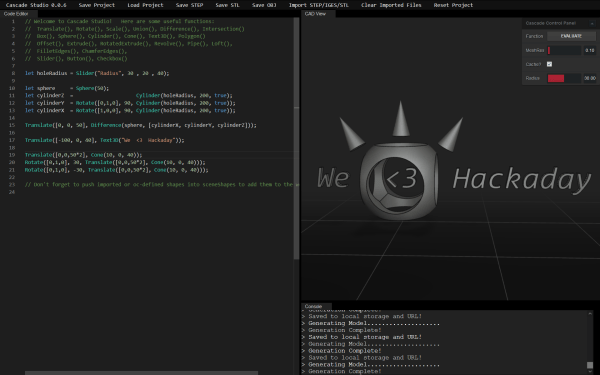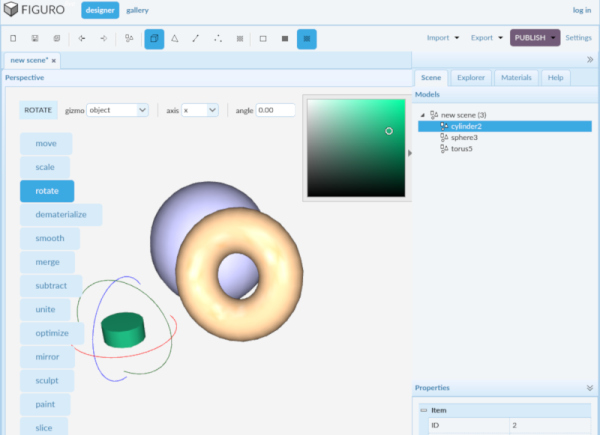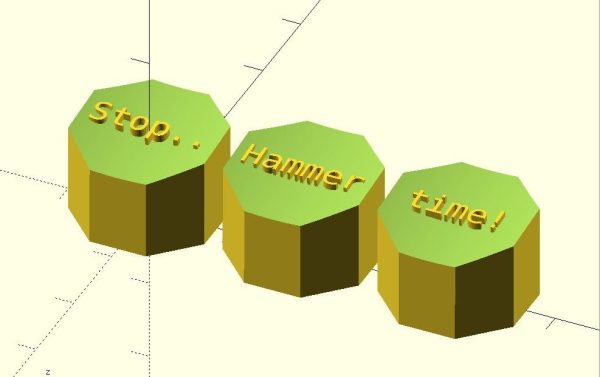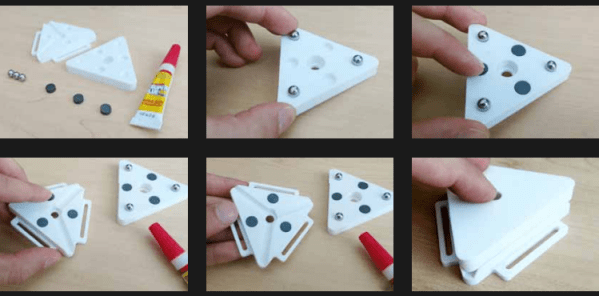Strong opinions exist on both sides about OpenSCAD. The lightweight program takes megabytes of space, not gigabytes, so many people have a copy, even if they’ve never written a shape. Some people adore the text-only modeling language, and some people abhor the minimal function list. [Johnathon ‘Zalo’ Selstad] appreciates the idea but wants to see something more robust, and he wants to see it in your browser. His project CascadeStudio has a GitHub repo and a live link so you can start tinkering in a new window straight away.
cad124 Articles
Autodesk Blinks, Keeps STEP File Export In Free Version Of Fusion 360
Good news, Fusion 360 fans — Autodesk just announced that they won’t be removing support for STEP file exports for personal use licensees of the popular CAD/CAM platform after all.
As we noted last week, Autodesk had announced major changes to the free-to-use license for Fusion 360. Most of the changes, like the elimination of simulations, rolling back of some CAM features, and removal of generative design tools didn’t amount to major workflow disruptions for many hobbyists who have embraced the platform. But the loss of certain export formats, most notably STEP files, was a bone of contention and the topic of heated discussion in the makerverse. Autodesk summed up the situation succinctly in their announcement, stating that the reversal was due to “unintended consequences for the hobbyist community.”
While this is great news, bear in mind that the other changes to the personal use license are still scheduled to go into effect on October 1, while the planned change to limit the number of active projects will go into effect in January 2021. So while Fusion 360 personal use licensees will still have STEP files, the loss of other export file formats like IGES and SAT are still planned.
Figuro Draws 3D In Browser
We would have never guessed there would be so many browser-based CAD packages. While TinkerCAD is great for simple things, there are also packages such as OnShape that rival commercial CAD programs. A site calle Figuro claims to occupy the space between TinkerCAD and Blender. We aren’t so sure, but it is an interesting entry into the field. Apparently, Figuro has been around for some time, but has recently had a major face lift. The new interface looks good, but it has invalidated a number of video tutorials on their YouTube channel.
One of the things we like about TinkerCAD is it is highly discoverable. That is, you can fire it up, play with it a bit, and probably do quite a few things. Maybe it is just us, but Figuro didn’t give us the same experience. It is easy enough to draw simple shapes. But trying to multiselect was unreliable. Panning and rotating the view was very sensitive too, so we found we were occasionally lost in the work view with no easy way to reset the view. Even something as simple as subtracting one shape from another was painful.
Distance Learning Land
[familylovermommy] has been homeschooling her kids even before the pandemic, so she’s pretty well-versed on being a learning coach and a teacher. One of the activities she designed for her boys has them creating 3D models using Tinkercad. In the spirit of openness and cultivating freethinking, she did not give them very many constraints. But rather, gave them the liberty to creatively design whatever scene they imagined.
In the Instructable, she shares her sons’ designs along with instructions to recreate the models. The designs as you’ll see are pretty extensive, so she embedded the Tinkercad designs directly into it. You can even see a number of video showcases as well.
This is a really cool showcase of some pretty stellar workmanship. Also, maybe a bit of inspiration for some of our readers who are creating work from home activities of their own.
While you’re at it, check out some of these other work-from-home hacks.
Autodesk Announces Major Changes To Fusion 360 Personal Use License Terms
Change is inevitable, and a part of life. But we’re told that nobody likes change. So logically, it seems we’ve proved nobody likes life. QED.
That may be a reach, but judging by the reaction of the Fusion 360 community to the announced changes to the personal use license, they’re pretty much hating life right now. The clear message from Autodesk is that Fusion 360 — the widely used suite of CAD and CAM software — will still offer a free-to-use non-commercial license for design and manufacturing work, with the inclusion of a few very big “buts” that may be deal-breakers for some people. The changes include:
- Project storage is limited to 10 active and editable documents
- Exports are now limited to a small number of file types. Thankfully this still includes STL files but alas, DXF, DWG, PDF exports are all gone
- Perhaps most importantly to the makerverse,
STEP, SAT, and IGES file types can no longer be exported, the most common files for those who want to edit a design using different software. - 2D drawings can now only be single sheet, and can only be printed or plotted
- Rendering can now only be done locally, so leveraging cloud-based rendering is no longer possible
- CAM support has been drastically cut back: no more multi-axis milling, probing, automatic tool changes, or rapid feeds, but support for 2, 2.5, and 3 axis remains
- All support for simulation, generative design, and custom extensions has been removed
Most of these changes go into effect October 1, with the exception of the limit on active project files which goes into effect in January of 2021. We’d say that users of Fusion 360’s free personal use license would best be advised to export everything they might ever think they need design files for immediately — if you discover you need to export them in the future, you’ll need one of the other licenses to do so.
To be fair, it was pretty clear that changes to the personal use license were coming a while ago with the consolidation of paid-tier licenses almost a year ago, and the cloud-credit system that monetized rendering/simulation/generative design services happening on the Autodesk servers. Features removed from the free license in this week’s announcement remain in place for paid subscriptions as well as the educational and start-up license options.
The problem with these personal use licenses is that it’s easy to get used to them and think of them as de facto open-source licenses; changing the terms then ends up leaving a bad taste in everyone’s mouth. To their credit, Autodesk is offering a steep discount on the commercial license right now, which might take some of the sting out of the changes.
Update 09-25-2020: Autodesk has announced that STEP file export will remain in the free version of Fusion 360
Keycap Customizer Brings All Your Caps To The Board
With bright colors and often intricate designs, after the physical shape of a keyboard the most conspicuous elements are surely the keycaps. Historically dictated by the stem of the key switch it attaches to, keycaps come in a variety of sizes, colors, profiles, and designs. As they necessarily include small features with tight tolerances to fit the stem of their key switch, injection molding is the classic manufacturing technique for a keycap. But as hobbyist 3D printing matures and resin printers become more accessible, home keycap manufacturing is increasingly good option. Instead of designing each cap by hand, consider trying [rsheldiii]’s KeyV2 OpenSCAD script to create custom caps with ease.
To cover the basics, KeyV2 can generate full keycap sets with Cherry or Alps stems, in the SA, DSA, DCS profiles (and more!) for any typically sized keyboard. Generating a particular cap of arbitrary profile, position, and size is just a short chain of function calls away. But standard keycap sets aren’t the highlight of this toolset.

If you’re not an OpenSCAD aficionado yet, visit [Brian Benchoffs] great getting-started guide or our other coverage to get a feel for what the tool can do. Part of OpenSCAD’s attraction is that it is the the paragon of parametric modeling. It’s declarative part files ensure that no parameter goes undefined, which is a perfect fit for KeyV2.
The root file upon which all caps are based on has about 150 keycap parameters which can be tweaked, and that’s before more elaborate customization. Making simple “artisan” caps is a snap, as the magic of OpenSCAD means the user can perform any Boolean operations they need on top of the fully parameterized keycap. Combining an arbitrary model with a keycap is one union() away. See the README for examples.
For the prospective user of KeyV2 worried about complexity; don’t be, the documentation is a treat. Basic use to generate standard keycaps is simple, and there are plenty of commented source files and examples to make more complex usage easy. Thinking about a new keyboard? Check out our recent spike in clacky coverage.
3D Printable Kinematic Couplings, Ready To Use
Time may bring change, but kinematic couplings don’t. This handy kinematic couplings resource by [nickw] was for a design contest a few years ago, but what’s great is that it includes ready-to-use models intended for 3D printing, complete with a bill of materials (and McMaster-Carr part numbers) for hardware. The short document is well written and illustrated with assembly diagrams and concise, practical theory. The accompanying 3D models are ready to be copied and pasted anywhere one might find them useful.
What are kinematic couplings? They are a way to ensure that two parts physically connect, detach, and re-connect in a precise and repeatable way. The download has ready-to-use designs for both a Kelvin and Maxwell system kinematic coupling, and a more advanced design for an optomechanical mount like one would find in a laser system.
The download from Pinshape requires a free account, but the models and document are licensed under CC – Attribution and ready to use in designs (so long as the attribution part of the license is satisfied, of course.) Embedded below is a short video demonstrating the coupling using the Maxwell system. The Kelvin system is similar.
Continue reading “3D Printable Kinematic Couplings, Ready To Use”
















